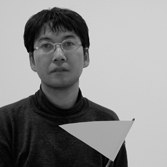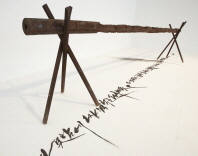
Birth
1963, Chungcheongnam-do
Genre
Painting, Sculpture, Installation, Photography
Homepage
The Works of Jongku Kim
1. Metal Sculptor Jongku Kim
Jongku Kim is a metal sculptor with anattachment for metal like no one else. Previously he erected elongated statuesmade from solid metal, but more recently he is opening a new sculptural worldcreated horizontally with ‘ground’ metal powder. The transfer from the verticalobject world to the horizontal dematerialized non-object world signifies themove from the objective material world to the subjective metal one, and theshift from the real world to the virtual one. In addition, from the feministpoint of view, the vertical orientation may be linked to male power, while thehorizontal one can be related to feminine embrace.
However, rather than focusing on theconceptual and aesthetical aspects of his work or on the gender specific traitsimbedded in his art, I would first like to discuss the particularity of hismedium and his peculiar usage of it. The way he uses meal is highly distinctiveand unique. In the past he produced structural forms by grinning metal as if itwere stone, and nowadays he has begun to use the resulting scrap metal power ashis creative medium. Although metals have traditionally always been one of themost commonly used materials in sculptures, he has successfully presented newsculpting world using special treatment of it.
Whereas metal sculptures are generallyformed by casting and welding processes, he created metal works by carving,grinding, and polishing of metal block. Compared to cast or weld sculptures,whose emphasis lies in outer form or structural interests, in traditional ‘Sculptural’sculptures formed by carving, grinding, and polishing, the labor and itsprocess become important aspects. In Kim’s work, where such sculptural labor iscrucial in actually generating the sculptural shape, the encounter of materialand creator, the collision of matter and action lead to the unexpected andincidental birth of sculptural form. Here, the process outweighs the final formand pure labor takes the place of creative action, As his current metal powderworks still require the manual hardship of grinding a metal block, laborcomprises the key element that envelopes all of his work.
Metal power is a remnant of sculpturallabor, that is, of his sculptural creation. Sculptural labor is an action ofcreation that gives life to the metal block. It is also an act of destructionthat damages the original block. In the manner an organism lead to new lifewith its own death, the metal block achieves creation as a sculpture onlythrough a self-destructive process. Metal powder, by product of sculpturallabor, a simultaneous act of both creation and destruction, is physicalevidence of the ‘rhetoric of creation’, that is, destruction for creation orcreation for destruction.
2. New Pictorialist Sculpture Made by MetalPowder
He busily moves around the laid down mentalblock to grind for metal power in his studio. His movement, his endlesslymoving feet continuously buildup or demolish small and large mounds,continuously changing the metal topology. Being the sole ruler of the closedquarters, he is the one creating the metal powder landscape with his physicalmotions of cutting and grinding. The metal powder landscape, viewed from adistance, appears as a height-reduced abstract map. However, at the horizontaleye level, metal mounds appear as micro-mountains of varying peaks. Hismountainous metal powder landscape projected onto a monitor becomes a quiet andmystical mental landscape image. This is the fantastic micro-world created byKim, virtual world that doesn’t really exist.
In the end, the rediscovery of metal powderand his ensuing affection and attachment toward it guided Kim from the verticalworld to the horizontal one. Such change from vertical to horizontal led to histransformation from a sculptural to a pictorial form. Unsatisfied with his newfound medium. He seems to mistake the metal powder for Chinese ink in hisoriental style landscape and brush calligraphy. At times, he even “gives water”to his landscape and calligraphy, suggesting the metal powder to be alife-form. With this, his work instantaneously becomes an abstractexpressionist painting as the water-soaked metal powder glides down thepainting surface.
It should be noted that Kim creates newpictorialist sculptures using a completely different methodology that attemptedby western constructivism sculptors in the past. Through the alchemictransformation, or cryclic reincarnation from block metal to metal power and attimes form metal power to liqueid rust, Kim has changed the nature ofsculptural existence. Here, the importance of the non western concept of time,such as process, trace, nd transformation, as crucial factors in his work canbe seen. In conclusion, his metal powder work can be considered ‘metamorphicpictorialism’ that includes the passage of time, which is different from thewestern ‘constructive pictorialism’ in which sculptural elements were spatiallyarranged and structed.
Kim Hong-Hee (Director of Seoul Museum of Art)









